Abstract
The activities and toxicities of amantadine hydrochloride and rimantadine hydrochloride against influenza A/Alaska/6/77 (H3N2) and A/Bangkok/1/79 (H3N2) viruses were compared in organ cultures and ferret tracheal ciliated epithelium. Pretreatment of cultures with concentrations (0.5 and 1 micrograms/ml) comparable to those found in human serum after oral administration of amantadine revealed that rimantadine produced significantly longer protection than amantadine against virus-induced cytopathic effects. Correspondingly, rimantadine produced a comparable protective effect at four- to eight-fold-lower concentrations than amantadine. Both drugs produced increasing and similar effects at higher concentrations, which were comparable to those reported in nasal washings after aerosol administration of amantadine. At the concentrations tested, amantadine was nontoxic. However, at concentrations of 16 and 32 micrograms/ml, rimantadine was toxic to the ciliated epithelium after 10 to 21 days of continuous exposure. When the drugs were added 24 h or more after infection, protection against cytopathic effects decreased markedly. Both drugs moderately suppressed virus production at concentrations of 0.5 to 16 micrograms/ml. However, no dose response or difference between the drugs was observed. Because of comparable antiviral activity at lower concentrations and greater activity at similar concentrations, rimantadine may be more useful than amantadine for oral prophylaxis and therapy of influenza.
Full text
PDF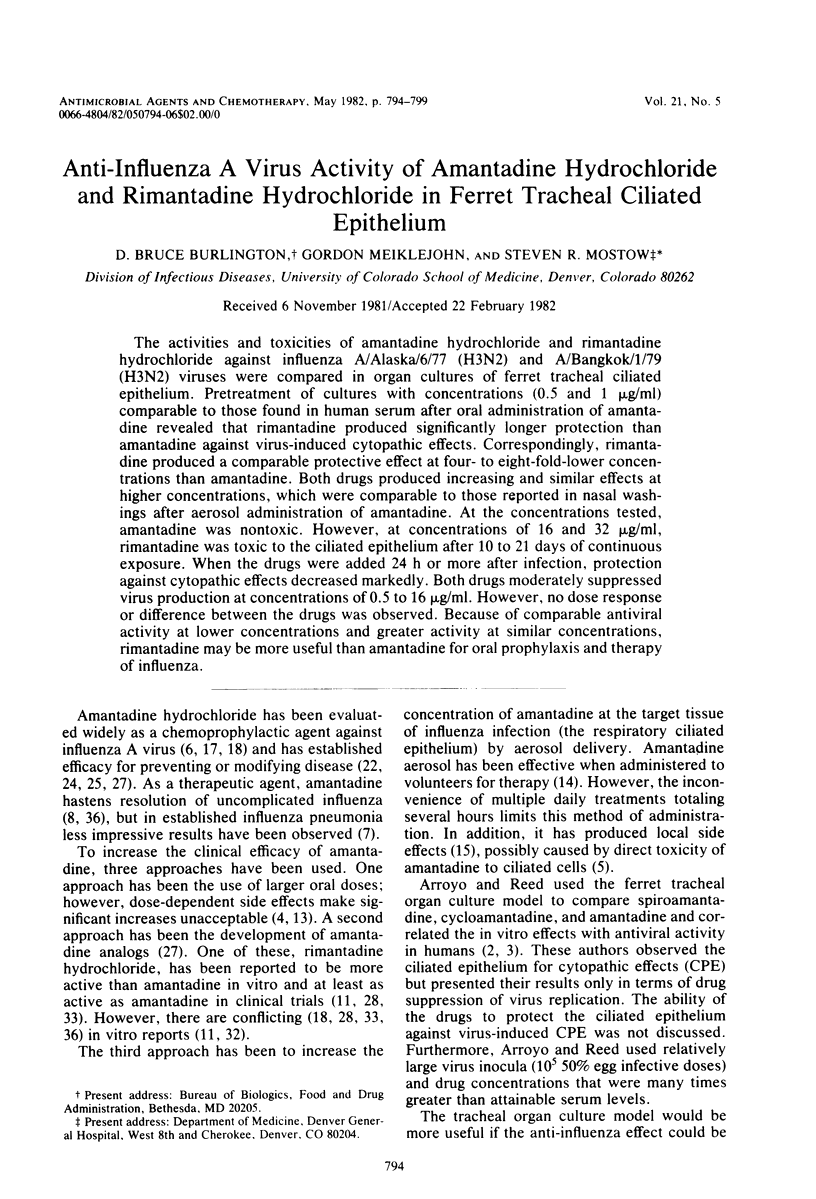
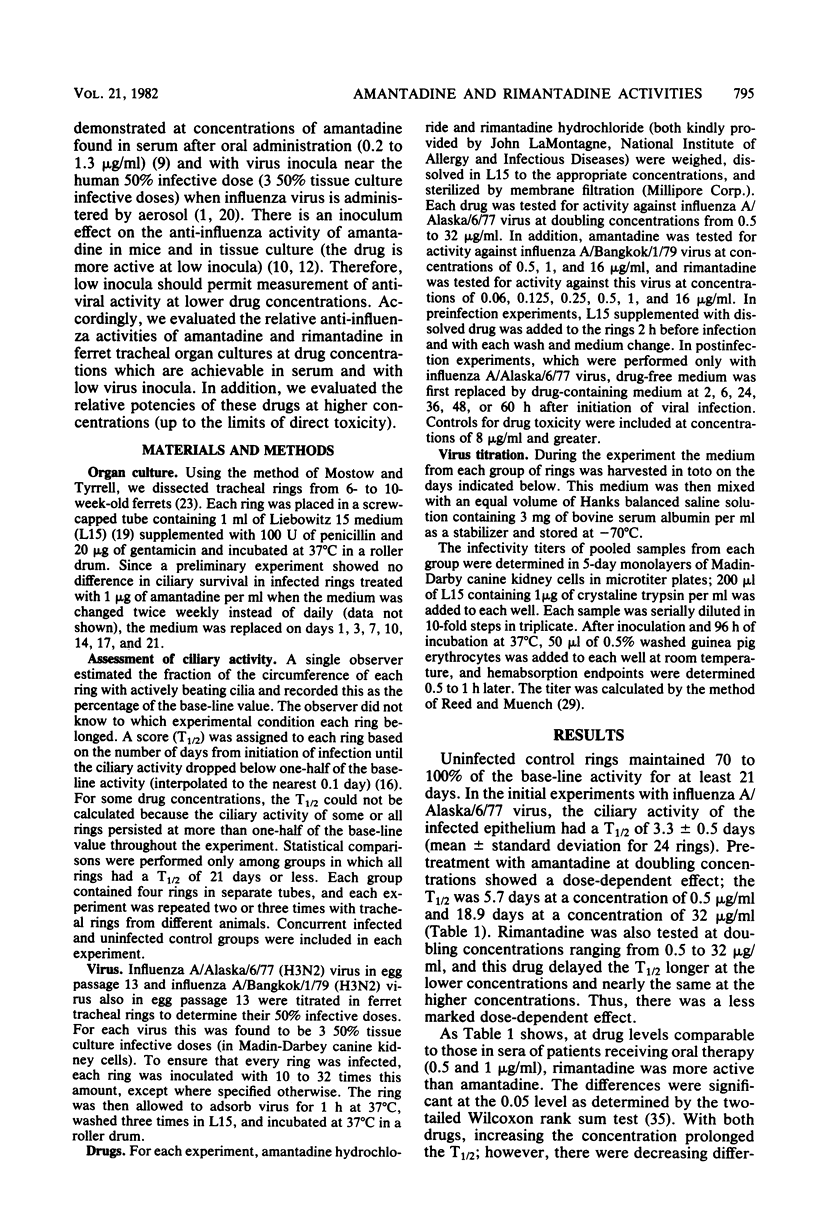
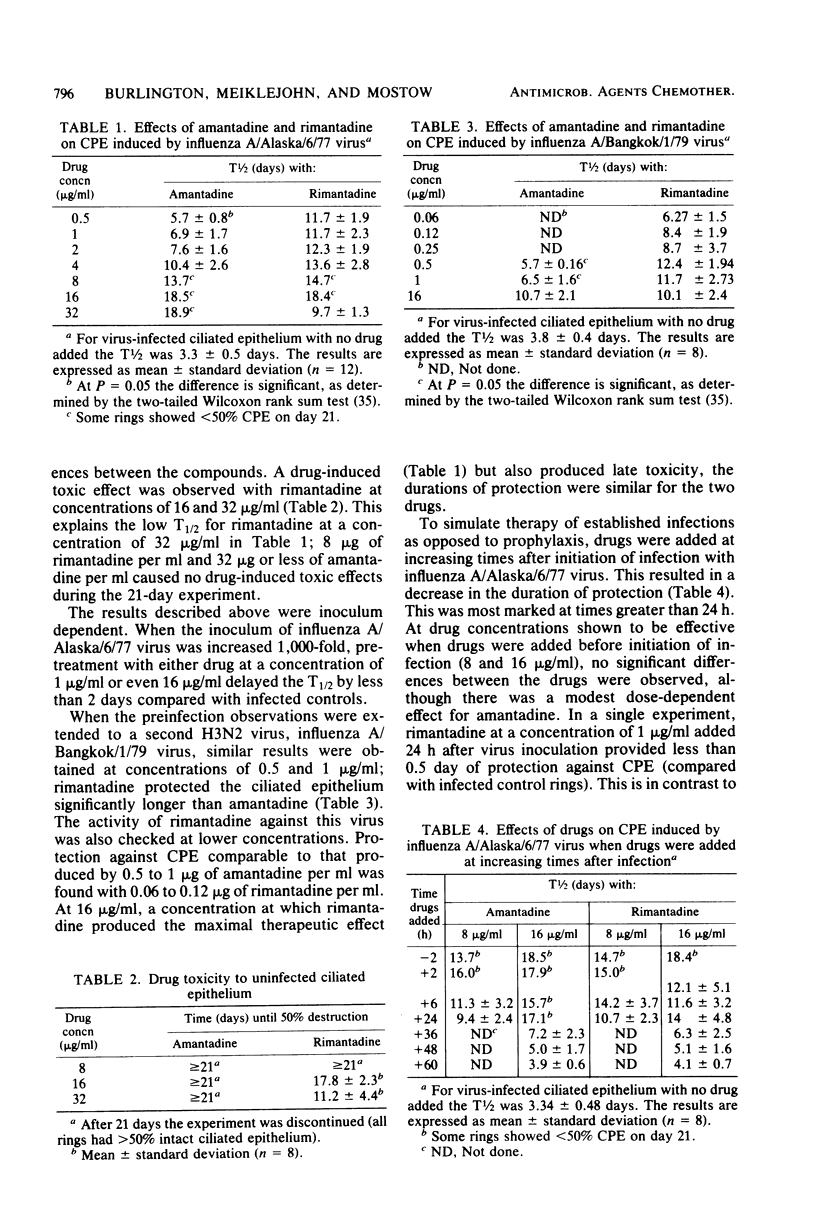

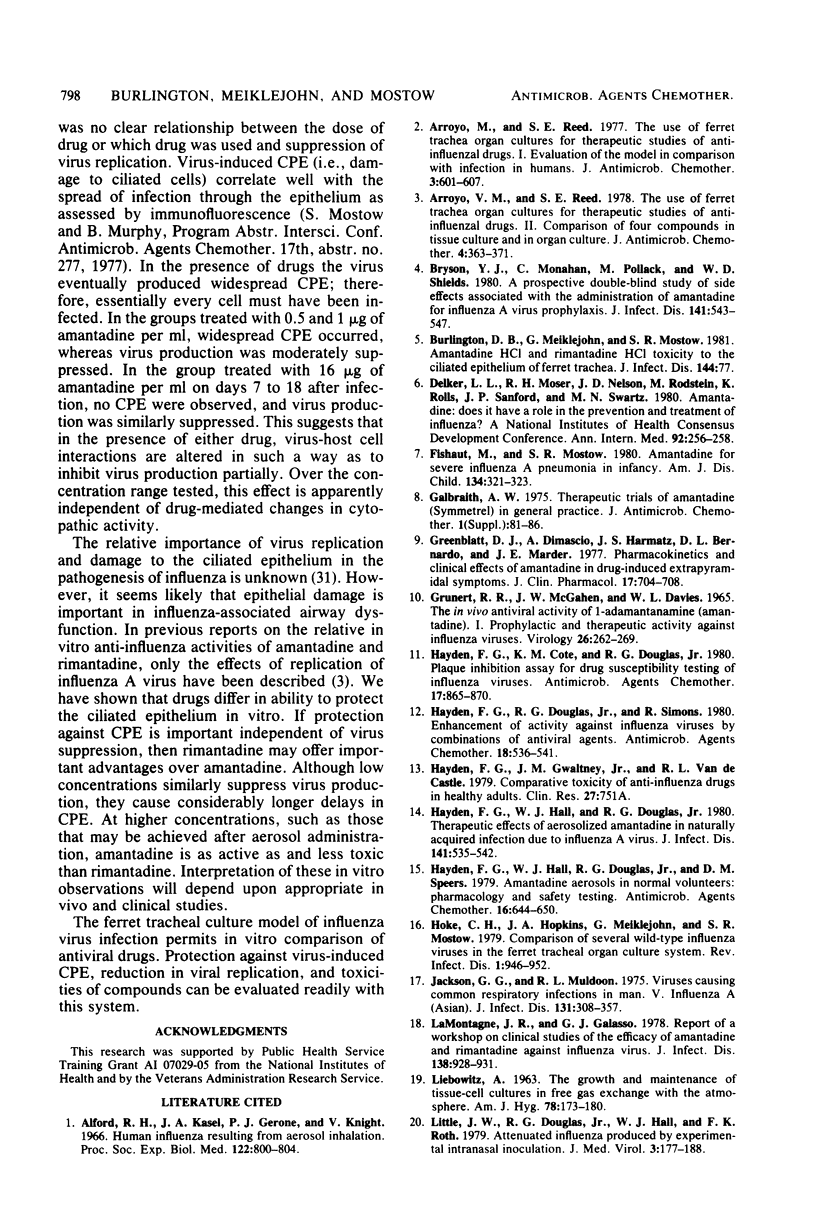
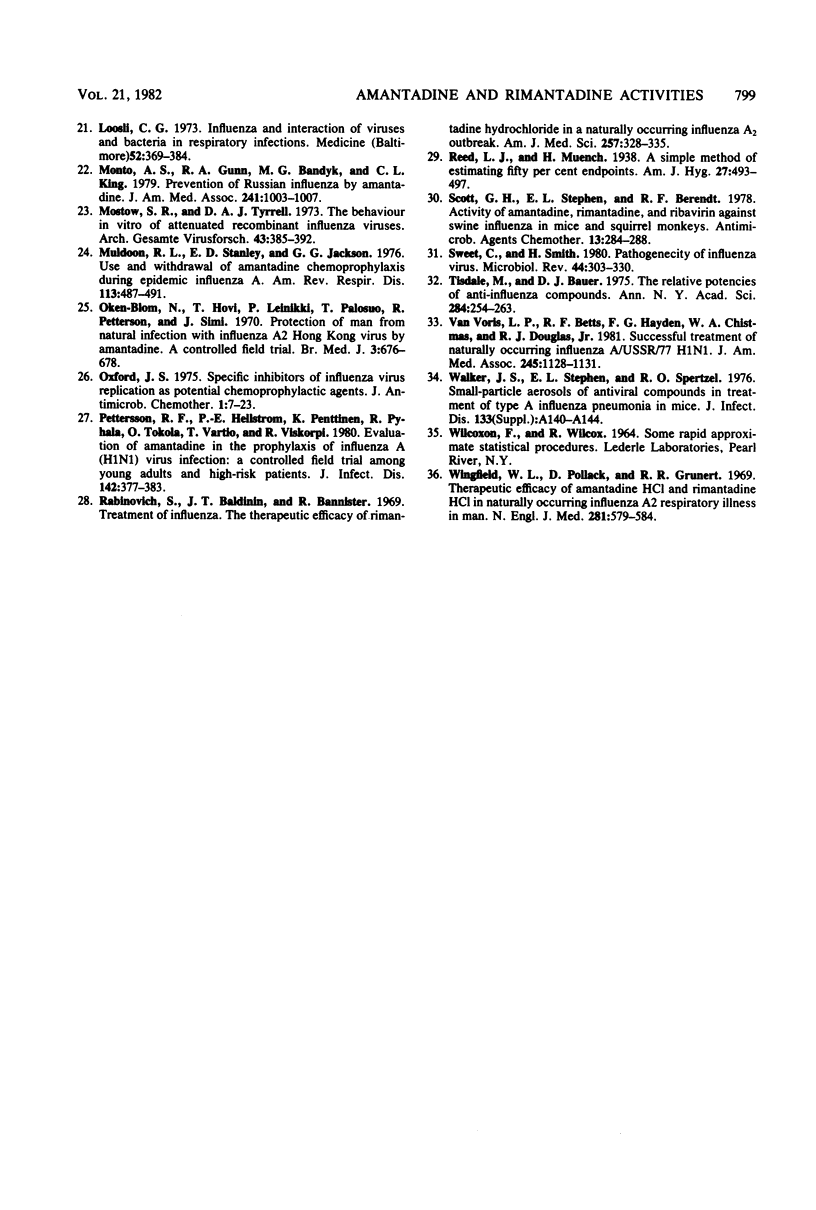
Selected References
These references are in PubMed. This may not be the complete list of references from this article.
- Alford R. H., Kasel J. A., Gerone P. J., Knight V. Human influenza resulting from aerosol inhalation. Proc Soc Exp Biol Med. 1966 Jul;122(3):800–804. doi: 10.3181/00379727-122-31255. [DOI] [PubMed] [Google Scholar]
- Arroyo M., Reed S. E. The use of ferret trachea organ cultures for therapeutic studies of anti-influenzal drugs. I. Evaluation of the model in comparison with infection in humans. J Antimicrob Chemother. 1977 Nov;3(6):601–607. doi: 10.1093/jac/3.6.601. [DOI] [PubMed] [Google Scholar]
- Bryson Y. J., Monahan C., Pollack M., Shields W. D. A prospective double-blind study of side effects associated with the administration of amantadine for influenza A virus prophylaxis. J Infect Dis. 1980 May;141(5):543–547. doi: 10.1093/infdis/141.5.543. [DOI] [PubMed] [Google Scholar]
- Burlington D. B., Meiklejohn G., Mostow S. R. Toxicity of amantadine and rimantadine for the ciliated epithelium of ferret tracheal rings. J Infect Dis. 1981 Jul;144(1):77–77. doi: 10.1093/infdis/144.1.77. [DOI] [PubMed] [Google Scholar]
- Fishaut M., Mostow S. R. Amantadine for severe influenza A pneumonia in infancy. Am J Dis Child. 1980 Mar;134(3):321–323. doi: 10.1001/archpedi.1980.02130150075022. [DOI] [PubMed] [Google Scholar]
- GRUNERT R. R., MCGAHEN J. W., DAVIES W. L. THE IN VIVO ANTIVIRAL ACTIVITY OF 1-ADAMANTANAMINE (AMANTADINE). I. PROPHYLACTIC AND THERAPEUTIC ACTIVITY AGAINST INFLUENZA VIRUSES. Virology. 1965 Jun;26:262–269. doi: 10.1016/0042-6822(65)90273-4. [DOI] [PubMed] [Google Scholar]
- Greenblatt D. J., DiMascio A., Harmatz J. S., Bernardo D. L., Marder J. E. Pharmacokinetics and clinical effects of amantadine in drug-induced extrapyramidal symptoms. J Clin Pharmacol. 1977 Nov-Dec;17(11-12):704–708. doi: 10.1002/j.1552-4604.1977.tb01545.x. [DOI] [PubMed] [Google Scholar]
- Hayden F. G., Cote K. M., Douglas R. G., Jr Plaque inhibition assay for drug susceptibility testing of influenza viruses. Antimicrob Agents Chemother. 1980 May;17(5):865–870. doi: 10.1128/aac.17.5.865. [DOI] [PMC free article] [PubMed] [Google Scholar]
- Hayden F. G., Douglas R. G., Jr, Simons R. Enhancement of activity against influenza viruses by combinations of antiviral agents. Antimicrob Agents Chemother. 1980 Oct;18(4):536–541. doi: 10.1128/aac.18.4.536. [DOI] [PMC free article] [PubMed] [Google Scholar]
- Hayden F. G., Hall W. J., Douglas R. G., Jr, Speers D. M. Amantadine aerosols in normal volunteers: pharmacology and safety testing. Antimicrob Agents Chemother. 1979 Nov;16(5):644–650. doi: 10.1128/aac.16.5.644. [DOI] [PMC free article] [PubMed] [Google Scholar]
- Hayden F. G., Hall W. J., Douglas R. G., Jr Therapeutic effects of aerosolized amantadine in naturally acquired infection due to influenza A virus. J Infect Dis. 1980 May;141(5):535–542. doi: 10.1093/infdis/141.5.535. [DOI] [PubMed] [Google Scholar]
- Hoke C. H., Jr, Hopkins J. A., Meiklejohn G., Mostow S. R. Comparison of sevral wild-type influenza viruses in the ferret tracheal organ culture system. Rev Infect Dis. 1979 Nov-Dec;1(6):946–954. doi: 10.1093/clinids/1.6.946. [DOI] [PubMed] [Google Scholar]
- Jackson G. G., Muldoon R. L. Viruses causing common respiratory infections in man. V. influenza A (Asian). J Infect Dis. 1975 Mar;131(3):308–357. doi: 10.1093/infdis/131.3.308. [DOI] [PubMed] [Google Scholar]
- LEIBOVITZ A. THE GROWTH AND MAINTENANCE OF TISSUE-CELL CULTURES IN FREE GAS EXCHANGE WITH THE ATMOSPHERE. Am J Hyg. 1963 Sep;78:173–180. doi: 10.1093/oxfordjournals.aje.a120336. [DOI] [PubMed] [Google Scholar]
- LaMontagne J. R., Galasso G. J. From the National Institutes of Health. Report of a workshop on clinical studies of the efficacy of amantadine and rimantadine against influenza vireus. J Infect Dis. 1978 Dec;138(6):928–931. doi: 10.1093/infdis/138.6.928. [DOI] [PubMed] [Google Scholar]
- Little J. W., Douglas R. G., Jr, Hall W. J., Roth F. K. Attenuated influenza produced by experimental intranasal inoculation. J Med Virol. 1979;3(3):177–188. doi: 10.1002/jmv.1890030303. [DOI] [PubMed] [Google Scholar]
- Loosli C. G. Influenza and the interaction of viruses and bacteria in respiratory infections. Medicine (Baltimore) 1973 Sep;52(5):369–384. doi: 10.1097/00005792-197309000-00001. [DOI] [PubMed] [Google Scholar]
- Monto A. S., Gunn R. A., Bandyk M. G., King C. L. Prevention of Russian influenza by amantadine. JAMA. 1979 Mar 9;241(10):1003–1007. [PubMed] [Google Scholar]
- Mostow S. R., Tyrrell D. A. The behaviour in vitro of attenuated recombinant influenza viruses. Arch Gesamte Virusforsch. 1973;43(4):385–392. doi: 10.1007/BF01556156. [DOI] [PMC free article] [PubMed] [Google Scholar]
- Muldoon R. L., Stanley E. D., Jackson G. G. Use and withdrawal of amantadine chemoprophylaxis during epidemic influenza A. Am Rev Respir Dis. 1976 Apr;113(4):487–491. doi: 10.1164/arrd.1976.113.4.487. [DOI] [PubMed] [Google Scholar]
- Oker-Blom N., Hovi T., Leinikki P., Palosuo T., Pettersson R., Suni J. Protection of man from natural infection with influenza A2 Hong Kong virus by amantadine: a controlled field trial. Br Med J. 1970 Sep 19;3(5724):676–678. doi: 10.1136/bmj.3.5724.676. [DOI] [PMC free article] [PubMed] [Google Scholar]
- Oxford J. S. Specific inhibitors of influenza virus replication as potential chemoprophylactic agents. J Antimicrob Chemother. 1975 Mar;1(1):7–23. doi: 10.1093/jac/1.1.7. [DOI] [PubMed] [Google Scholar]
- Pettersson R. F., Hellström P. E., Penttinen K., Pyhälä R., Tokola O., Vartio T., Visakorpi R. Evaluation of amantadine in the prophylaxis of influenza A (H1N1) virus infection: a controlled field trial among young adults and high-risk patients. J Infect Dis. 1980 Sep;142(3):377–383. doi: 10.1093/infdis/142.3.377. [DOI] [PubMed] [Google Scholar]
- Rabinovich S., Baldini J. T., Bannister R. Treatment of influenza. The therapeutic efficacy of rimantadine HC1 in a naturally occurring influenza A2 outbreak. Am J Med Sci. 1969 May;257(5):328–335. doi: 10.1097/00000441-196905000-00005. [DOI] [PubMed] [Google Scholar]
- Scott G. H., Stephen E. L., Berendt R. F. Activity of amantadine, rimantadine, and ribavirin against swine influenza in mice and squirrel monkeys. Antimicrob Agents Chemother. 1978 Feb;13(2):284–288. doi: 10.1128/aac.13.2.284. [DOI] [PMC free article] [PubMed] [Google Scholar]
- Sweet C., Smith H. Pathogenicity of influenza virus. Microbiol Rev. 1980 Jun;44(2):303–330. doi: 10.1128/mr.44.2.303-330.1980. [DOI] [PMC free article] [PubMed] [Google Scholar]
- Tisdale M., Bauer D. J. The relative potencies of anti-influenza compounds. Ann N Y Acad Sci. 1977 Mar 4;284:254–263. doi: 10.1111/j.1749-6632.1977.tb21958.x. [DOI] [PubMed] [Google Scholar]
- Van Voris L. P., Betts R. F., Hayden F. G., Christmas W. A., Douglas R. G., Jr Successful treatment of naturally occurring influenza A/USSR/77 H1N1. JAMA. 1981 Mar 20;245(11):1128–1131. doi: 10.1001/jama.245.11.1128. [DOI] [PubMed] [Google Scholar]
- Walker J. S., Stephen E. L., Spertzel R. O. Small-particle aerosols of antiviral compounds in treatment of type A influenza pneumonia in mice. J Infect Dis. 1976 Jun;133 (Suppl):A140–A144. doi: 10.1093/infdis/133.supplement_2.a140. [DOI] [PubMed] [Google Scholar]
- Wingfield W. L., Pollack D., Grunert R. R. Therapeutic efficacy of amantadine HCl and rimantadine HCl in naturally occurring influenza A2 respiratory illness in man. N Engl J Med. 1969 Sep 11;281(11):579–584. doi: 10.1056/NEJM196909112811102. [DOI] [PubMed] [Google Scholar]


